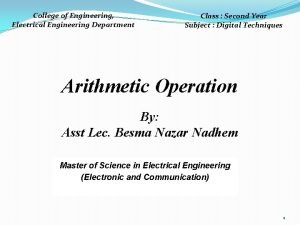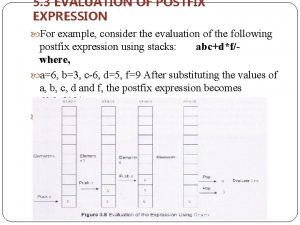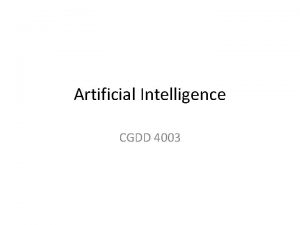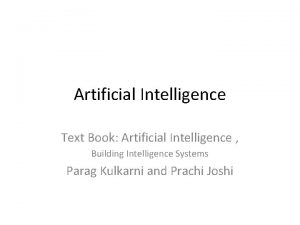Python Tutorial Lecture for EE 562 Artificial Intelligence









![Lists >>> mylist = ['a', 'b', 'c'] >>> mylist[0] 'a‘ >>> mylist[1] 'b' >>> Lists >>> mylist = ['a', 'b', 'c'] >>> mylist[0] 'a‘ >>> mylist[1] 'b' >>>](https://slidetodoc.com/presentation_image/35b1988c0a62578888032127a88b1596/image-10.jpg)
![Slices of Lists >>> mylist ['a', 'b', 'c', 'd'] >>> len(mylist) 4 >>> mylist[0: Slices of Lists >>> mylist ['a', 'b', 'c', 'd'] >>> len(mylist) 4 >>> mylist[0:](https://slidetodoc.com/presentation_image/35b1988c0a62578888032127a88b1596/image-11.jpg)

![Strings work a lot like lists! >>> mystring = 'abcd' >>> mystring[0] 'a' >>> Strings work a lot like lists! >>> mystring = 'abcd' >>> mystring[0] 'a' >>>](https://slidetodoc.com/presentation_image/35b1988c0a62578888032127a88b1596/image-13.jpg)
![Dictionaries give us look-up table capabilities. >>> translate = {} >>> translate['I'] = 'Ich' Dictionaries give us look-up table capabilities. >>> translate = {} >>> translate['I'] = 'Ich'](https://slidetodoc.com/presentation_image/35b1988c0a62578888032127a88b1596/image-14.jpg)






- Slides: 20

Python Tutorial Lecture for EE 562 Artificial Intelligence for Engineers 1

Why Python for AI? • For many years, we used Lisp, because it handled lists and trees really well, had garbage collection, and didn’t require type declarations. • Lisp and its variants finally went out of vogue, and for a while, we allowed any old language, usually Java or C++. This did not work well. The programs were big and more difficult to write. • A few years ago, the AI faculty started converting to Python. It has the object-oriented capabilities of Java and C++ with the simplicity for working with list and tree structures that Lisp had with a pretty nice, easy-to -use syntax. I learned it with very little work. 2

Getting Started • Download and install Python from www. python. org onto your computer. EE is updating to use Python 3. Python 2. 7 works fine for plain search programs. We’ll let you know about the game interface. • Read “Python as a Second Language, ” a tutorial that Prof. Tanimoto wrote for CSE 415 students: • https: //courses. cs. washington. edu/courses/cse 4 15/18 wi/uwnetid/Tanimoto-PSL. pdf 3

Python Data Types • • • int float str bool list tuple dict function builtin_function_ or_method 105 3. 14159 “Selection: ”, ‘a string’ True, False [‘apple’, ‘banana’, ‘orange’] (3. 2, 4. 5, 6. 3) {‘one’: 1, ‘two’: 2} lambda x: 2*x math. sqrt 4

Interacting with Python $ python Python 2. 7. 5 (default, Nov 12 2013, 16: 18: 42) [GCC 4. 8. 2 20131017 (Red Hat 4. 8. 2 -1)] on linux 2 Type "help", "copyright", "credits" or "license" for more information. >>> 5 + 7 12 >>> x = 5 + 7 >>> x 12 >>> print('x = '+str(x)) x = 12 >>> x = 'apple' >>> x + x 'apple' >>> print('x is an '+x) x is an apple 5

Defining Functions >>> def sqr(x): You have to indent the lines of the function. . . return x*x. . . >>> sqr(5) 25 >>> sqr(75) 5625 >>> sqr(3. 14) 9. 8596 >>> sqr('notanumber') Nice trace for execution errors. Traceback (most recent call last): File "<stdin>", line 1, in <module> File "<stdin>", line 2, in sqr Type. Error: can't multiply sequence by non-int of type 'str' 6

Defining a Recursive Function >>> def factorial(n): . . . if n < 1: . . . return 0. . . if n == 1: . . . return 1. . . return n * factorial(n-1). . . >>> factorial(3) 6 >>> factorial(10) 3628800 >>> factorial(-1) 0 Bad Version: >>>def fact(n): if n==1: return 1 else: return n * fact(n-1) File "<stdin>", line 5, in fact. . . File "<stdin>", line 5, in fact Runtime. Error: maximum recursion depth exceeded 7

Scopes of Bindings: In general, declare global variables to save worry, required if you change them. Global y not needed here and we have two different z’s. Global y used here to change y inside the function. >>> x = 5 >>> y = 6 >>> z = 7 >>> def fee(x): . . . z=x+y. . . return z. . . >>> r = fee(2) >>> r 8 >>> def foo(x): . . . global y. . . z=x+y. . . y=y+1. . . return z. . . >>> q = foo(2) >>> q 8 >>> y 7 8

Lists • We use lists heavily in AI. • Lisp lists had two parts: – car (the head or first element of the list) – cdr (the tail or remainder of the list) • Python is MUCH more versatile. • Lists are like arrays in that you can refer to any element and yet you can also work with the head and tail and much more. 9
![Lists mylist a b c mylist0 a mylist1 b Lists >>> mylist = ['a', 'b', 'c'] >>> mylist[0] 'a‘ >>> mylist[1] 'b' >>>](https://slidetodoc.com/presentation_image/35b1988c0a62578888032127a88b1596/image-10.jpg)
Lists >>> mylist = ['a', 'b', 'c'] >>> mylist[0] 'a‘ >>> mylist[1] 'b' >>> mylist[1: ] ['b', 'c'] >>> mylist[2: ] ['c'] >>> mylist[-1] 'c‘ >>> mylist. insert(3, 'd') >>> mylist ['a', 'b', 'c', 'd'] car (or head) cdr (or tail) append How do you insert at the beginning? 10
![Slices of Lists mylist a b c d lenmylist 4 mylist0 Slices of Lists >>> mylist ['a', 'b', 'c', 'd'] >>> len(mylist) 4 >>> mylist[0:](https://slidetodoc.com/presentation_image/35b1988c0a62578888032127a88b1596/image-11.jpg)
Slices of Lists >>> mylist ['a', 'b', 'c', 'd'] >>> len(mylist) 4 >>> mylist[0: len(mylist)] ['a', 'b', 'c', 'd'] >>> mylist[0: len(mylist): 2] ['a', 'c'] >>> mylist[: : -1] ['d', 'c', 'b', 'a'] >>> mylist[1: ] ? go through mylist by ones go through mylist by twos go through mylist in reverse 11

Iterating through Lists >>> for e in mylist: . . . print('element is '+e). . . element is a element is b element is c element is d >>> count = 0 >>> while count < len(mylist): . . . print(mylist[count]). . . count += 1. . . a b c d 12
![Strings work a lot like lists mystring abcd mystring0 a Strings work a lot like lists! >>> mystring = 'abcd' >>> mystring[0] 'a' >>>](https://slidetodoc.com/presentation_image/35b1988c0a62578888032127a88b1596/image-13.jpg)
Strings work a lot like lists! >>> mystring = 'abcd' >>> mystring[0] 'a' >>> mystring[0: 2] 'ab' >>> mystring[-1] 'd' >>> mystring[: : -1] 'dcba' 13
![Dictionaries give us lookup table capabilities translate translateI Ich Dictionaries give us look-up table capabilities. >>> translate = {} >>> translate['I'] = 'Ich'](https://slidetodoc.com/presentation_image/35b1988c0a62578888032127a88b1596/image-14.jpg)
Dictionaries give us look-up table capabilities. >>> translate = {} >>> translate['I'] = 'Ich' >>> translate['go'] = 'gehe' >>> translate['to'] = 'zu' >>> translate['doctor'] = 'Artz' >>> translate['the'] = 'der' >>> print(translate['I']) Ich How can we print the translation of I go to the doctor? Is it correct German? 14

Functional Programming • Functions can be values that are assigned to variables or put in lists. • They can be arguments to or returned by functions. • They can be created dynamically at run time and applied to arguments. • They don’t have to have names. • This is like the lambda capability of Lisp 15

Example of Function Creation >>> def make_adder(y): . . . return lambda x: x + y. . . >>> f 4 = make_adder(4) >>> f 4(5) 9 >>> f 7 = make_adder(7) >>> f 7(5) 12 What does this mean? This is actually pretty tame. One can construct strings and make them into functions, too. 16

Object-Oriented Programming Unlike Lisp, Python is an object-oriented language, so you can program much as you did in Java. class Coord: "2 D Point Coordinates" def __init__(self, x=0, y=0): self. x = x self. y = y # def describe(self): return '('+str(self. x)+', '+str(self. y)+')' # def euclid(self, p 2): return ((self. x-p 2. x)**2+(self. y-p 2. y)**2)**0. 5 17

Using the Coord Object >>> p 1 = Coord(3, 5) >>> p 2 = Coord(2, 7) >>> p 1. describe() '(3, 5)' >>> p 2. describe() '(2, 7)' >>> p 1. euclid(p 2) 2. 23606797749979 >>> p 2. euclid(p 1) 2. 23606797749979 18

Writing Methods class Coord: "2 D Point Coordinates" def __init__(self, x=0, y=0): self. x = x self. y = y Write a method to add together two points and return a new point p 3 = the sum of them def add(self, p 2): 19

Main Program with Command Line Arguments import sys def add(a, b): return a+b # if __name__=='__main__': first = int(sys. argv[1]) second = int(sys. argv[2]) sum = add(first, second) print(str(sum)) python try. py 4 5 9 I stored this in file try. py 20
 Conceptual graph in artificial intelligence tutorial
Conceptual graph in artificial intelligence tutorial Ee 562
Ee 562 562-247-8422
562-247-8422 562-247-8422
562-247-8422 Site:slidetodoc.com
Site:slidetodoc.com Evaluate the postfix expression: 562 +124/
Evaluate the postfix expression: 562 +124/ 152 909 nearest hundred thousand
152 909 nearest hundred thousand Architecture of expert system
Architecture of expert system State space search
State space search Searching for solutions in artificial intelligence
Searching for solutions in artificial intelligence 15-780 graduate artificial intelligence
15-780 graduate artificial intelligence Knowledge manipulation in ai
Knowledge manipulation in ai Structural knowledge in ai
Structural knowledge in ai American association for artificial intelligence 17 mar
American association for artificial intelligence 17 mar Kecerdasan kepemimpinan
Kecerdasan kepemimpinan Uas kecerdasan buatan
Uas kecerdasan buatan Math for artificial intelligence
Math for artificial intelligence Peas diagram ai
Peas diagram ai 15-780 graduate artificial intelligence
15-780 graduate artificial intelligence Xkcd artificial intelligence
Xkcd artificial intelligence Fuzzy propositions examples
Fuzzy propositions examples







































